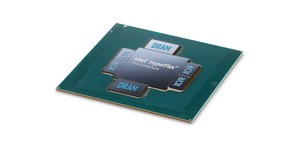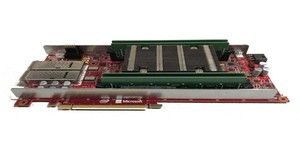
Intel is getting back into the ARM CPU game, thanks to its acquisition of Altera last year, launching the Intel Stratix 10 FPGA with ARM Cortex-A53 CPU cores.
While Intel is best known for pioneering the 32-bit x86 architecture and following rival AMD into the AMD64 (x86-64, as Intel would have it) era, the company has dabbled with alternatives in the past. Intel's ill-fated Itanium architecture may not have set the world on fire, but the company saw reasonable success with a range of StrongARM and XScale processors produced following a legal settlement with the Digital Equipment Corporation (DEC). Its decision to abandon ARM licensing in favour of building its own architectures exclusively came just ahead of the smartphone revolution that saw ARM designs catapulted into the most numerous processors in the world, and now it seems Intel is getting back into the ARM market through the back door.
Unlike the company's recently announced partnership with ARM, which simply sees the company providing ARM licensees with unused Intel foundry capacity, the Stratix 10 launch is all-Intel. While designed by the company's Altera division, acquired last year, the Stratix 10 features Intel branding exclusively - making the presence of a quad-core ARM Cortex-A53 central processing block, rather than one of Intel's Atom or Quark low-power parts, something of a surprise.
The ARM cores are, of course, not the primary focus of the Stratix family, serving only to run the underlying operating system and keep the field-programmable gate array (FPGA) - a series of logic gates which can be programmed to act as custom hardware without the expense of producing a true application-specific integrated circuit (ASIC) and with the potential to upgrade or modify the design via a firmware update - fed with data. Compared to Altera's earlier Stratix V chips, Intel claims, the new Stratix 10 doubles the core performance, draws up to 70 percent less power for equivalent performance, boasts five times the logic density thanks to the new 14nm tri-gate manufacturing process, and includes integrated High-Bandwidth Memory 2 (HBM2) in-package.
'The Stratix 10 is an excellent example of the FPGA innovation that Intel is delivering to customers,' claimed Intel's Dan McNamara in the launch announcement, with 'customers' largely referring to those in the networking and data centre markets looking to accelerated custom workloads. 'We are delivering samples of the Stratix 10 FPGAs to customers today, and I personally look forward to seeing the innovations our customers will be able to deliver to market with this game-changing technology.'
While Intel is best known for pioneering the 32-bit x86 architecture and following rival AMD into the AMD64 (x86-64, as Intel would have it) era, the company has dabbled with alternatives in the past. Intel's ill-fated Itanium architecture may not have set the world on fire, but the company saw reasonable success with a range of StrongARM and XScale processors produced following a legal settlement with the Digital Equipment Corporation (DEC). Its decision to abandon ARM licensing in favour of building its own architectures exclusively came just ahead of the smartphone revolution that saw ARM designs catapulted into the most numerous processors in the world, and now it seems Intel is getting back into the ARM market through the back door.
Unlike the company's recently announced partnership with ARM, which simply sees the company providing ARM licensees with unused Intel foundry capacity, the Stratix 10 launch is all-Intel. While designed by the company's Altera division, acquired last year, the Stratix 10 features Intel branding exclusively - making the presence of a quad-core ARM Cortex-A53 central processing block, rather than one of Intel's Atom or Quark low-power parts, something of a surprise.
The ARM cores are, of course, not the primary focus of the Stratix family, serving only to run the underlying operating system and keep the field-programmable gate array (FPGA) - a series of logic gates which can be programmed to act as custom hardware without the expense of producing a true application-specific integrated circuit (ASIC) and with the potential to upgrade or modify the design via a firmware update - fed with data. Compared to Altera's earlier Stratix V chips, Intel claims, the new Stratix 10 doubles the core performance, draws up to 70 percent less power for equivalent performance, boasts five times the logic density thanks to the new 14nm tri-gate manufacturing process, and includes integrated High-Bandwidth Memory 2 (HBM2) in-package.
'The Stratix 10 is an excellent example of the FPGA innovation that Intel is delivering to customers,' claimed Intel's Dan McNamara in the launch announcement, with 'customers' largely referring to those in the networking and data centre markets looking to accelerated custom workloads. 'We are delivering samples of the Stratix 10 FPGAs to customers today, and I personally look forward to seeing the innovations our customers will be able to deliver to market with this game-changing technology.'

MSI MPG Velox 100R Chassis Review
October 14 2021 | 15:04








Want to comment? Please log in.